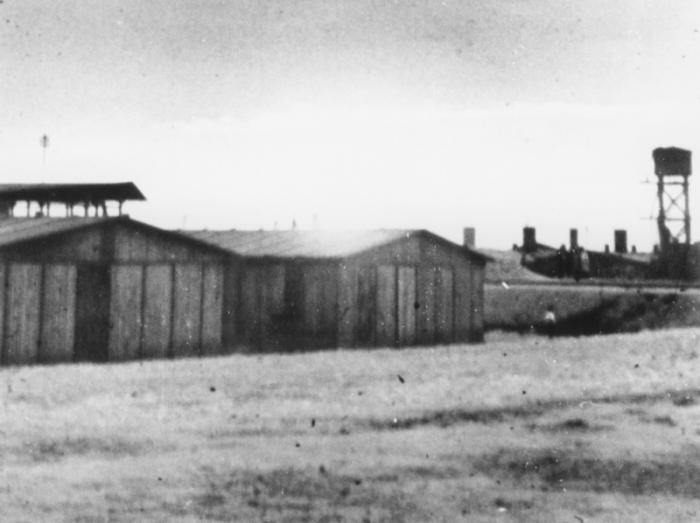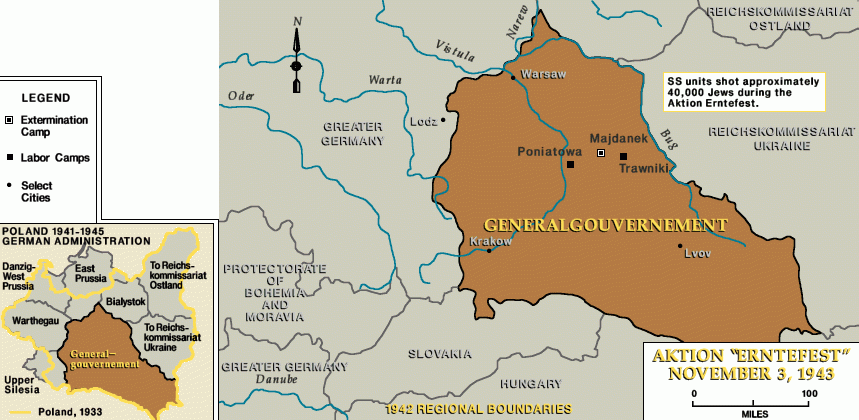
Trawniki: Key Dates
Explore a timeline of key events in the history of the Trawniki camp in German-occupied Poland.
September 1, 1939
Germany invades Poland, starting World War II.
June 22, 1941
Nazi Germany invades the Soviet Union.
Summer 1941
The SS and police authorities in the Lublin District establish a detention facility outside Trawniki, a town southeast of Lublin, on the orders of the SS and Police Leader (SS- und Polizeiführer-SSPF) for Lublin District, SS Major General Odilo Globocnik.
July 17, 1941
Globocnik is appointed Commissioner for the Establishment of SS and Police Bases (SS- und Polizeistutzpünkte) in the Eastern Territory.

September 1941
Globocnik transforms the Trawniki camp into a training camp for auxiliary police personnel to maintain security for proposed German settlements in the occupied Soviet Union. The first Soviet soldiers recruited from prisoner-of-war camps arrive at Trawniki soon after the change.
October 27, 1941
Globocnik appoints SS Captain Karl Streibel to command the Trawniki training camp.
1942
Trawniki also serves as a transit camp for local Jews. SS and police instructors use the local Jewish population for “training purposes.”
Summer 1942
After the construction of a labor camp adjacent to the training camp, Trawniki also serves as a forced-labor camp for Jews (Zwangsarbeitslager für Juden).
Autumn 1942
SS authorities move a brush factory and its laborers from the Miedzyrzec-Podlaski ghetto to Trawniki.
February 8, 1943
Globocnik signs a contract with the F.W. Schultz and Co., which provides that the Schultz fur production plant with 4,000 Jewish workers and the brush-making plant with 1,500 workers be transferred from the Warsaw ghetto to Trawniki. Globocnik names Streibel commander of the Trawniki labor camp. He names SS Master Sergeant Franz Bartetzko and his deputy, SS Staff Sergeant Josef Napieralla, to manage the day-to-day operations of the camp.
February 16, 1943
Transports begin to leave the Warsaw ghetto for Trawniki.
April 19, 1943
SS and police units under command of the SS and Police Leader in Warsaw, including a battalion of Trawniki-trained guards, seal off the Warsaw ghetto, intending to forcibly remove the Jewish residents to forced-labor camps and to kill those who resist. The operation sparks the Warsaw ghetto uprising. Between February 15 and April 30, the SS and police remove 2,848 men, 2,397 women, and 388 children from Warsaw to Trawniki.
September 1943
Two transports of Jewish workers arrive in Trawniki from the Minsk ghetto after its liquidation.
September 1943
Globocnik transfers out of Lublin.
September 1943
The SS leadership transfers the Trawniki complex to the jurisdiction of the SS Economic-Administration Main Office (SS-Wirtschafts-Verwaltungshauptamt-WVHA). Trawniki thus becomes a subcamp of Lublin/Majdanek.

November 3, 1943
The SS and police units shoot at least 6,000 Jewish inmates of Trawniki and its subcamp Dorohucza, eliminating virtually the entire workforce, in an action called Operation “Harvest Festival” (Unternehmen Erntefest). Himmler ordered the mass shooting sometime after learning of the October 1943 prisoner uprising in the Sobibor killing center.
May 1944
The SS transfers the small detachment of Jews who had been brought to Trawniki after the massacre to Lublin/Majdanek. The Trawniki labor camp is dissolved. Guards (Wachmänner) continue to train at Trawniki.
July 23, 1944
Soviet troops overrun Trawniki and Lublin. The Germans and guards flee as Soviet troops advance.
May 31, 1945
Globocnik commits suicide when he is captured by the British, in Carinthia.
1970
A West German court indicts Streibel, Napieralla, and four Trawniki company commanders, but acquits all six defendants in 1976.
Critical Thinking Questions
Learn about how the role of the Trawniki camp was uncovered and efforts to prosecute Trawniki officials and guards.
To what degree was the local population aware of this camp, its purpose, and the conditions within? How would you begin to research this question?

